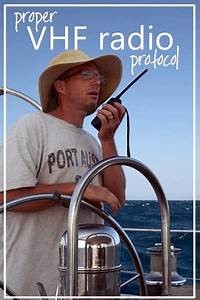Seamanship
VHF Radio Protocol
VHF radios play an important part in safety at sea and should be used with respect and understanding of FCC (part 80) and international treaty regulations.
VHF radio frequencies are used by commercial ships, and planes with licensed operators and call signs and monitored by USCG life-saving authorities. The FCC has limitations on what and how things should be said. Anyone can talk on the radio within these confines and pleasure boaters are not required to have an FCC permit to do so, but because this has to do primarily with safety there are certain fundamentals, i.e. protocols, that everyone must follow.
Here are some radio basics that all boaters should know:
- Radio transmission should be in English.
- The captain of the ship has ultimate control of the ship’s radio.
- Distress traffic (grave and imminent danger requesting immediate assistance) in radiotelephony is expressed by speaking the word “Mayday” 3x at the beginning of the message, followed by the call sign and or name of the vessel. Then the particulars that would facilitate rescue such as position, length, color, and type of vessel, number of persons onboard, and nature of distress are given.
- After Distress (see above), the next message priority is Urgent, which involves the safety of ship or person onboard. This is conveyed by speaking the word “Pan” 3x.
- Safety is the next message priority, which conveys a navigational or weather warning by speaking the word “Security” 3x.
- These three are the only messages that are general broadcast. All others should be directed to a specific vessel or station.
- Channel 16 (156.8 Mhz) should be monitored at all times. It is reserved for hailing and emergencies. Most radios have dual monitor switches that allow you to hear channel 16 and another channel at the same time. Commercial ships will monitor 16 and use channel 13 for hailing. You MUST switch to another channel for basic communications.
- When attempting to contact other vessels on channel 16, limit calling to 30 seconds. If no answer is received, wait 2 minutes before calling again.
- When you call another vessel, say the name three times and then ALWAYS identify your vessel. e.g., “BYC launch, BYC launch, BYC Launch, this is motor vessel Albacore channel 68, over.”
- The word “over” lets the other party know we are done talking and it is their turn to talk. “Clear” ends a transmission without further response. “Wilco”says that the message is received and will be complied with. “Roger” tells the other operator that all of a transmission has been received.
- If you hear other people talking on your frequency, let them finish. Don’t talk over or “step on” other radio traffic, and always listen before transmitting.
- Cursing and swearing is not allowed.
- Make it short and sweet. Get to the point. Remember the safety nature of the medium. If you want to talk about how the fish are biting or how great the weather is, make sure you are on a “non-working frequency” (those routinely monitored by harbor masters or marinas for instance). Or better yet have these private conversations on your cell phone. Needless or superfluous radio communications are not authorized in maritime service. The primary purpose of bridge to bridge communications is for navigational communication.
- Most cruising guides will provide the frequencies routinely monitored by harbor masters, marinas, and yacht clubs.
- Radio checks are a way of knowing your radio is sending and receiving properly. Again identify yourself, “radio test, radio test, radio test, M/V Albacore ch 68.” The proper response being, “M/V Albacore, loud and clear, (your location) Nantucket Harbor.” Better yet, use the new automated radio check system on ch. 28.
- Sign off properly when your call is complete: “This is M/V Albacore going back to 16/13, off and clear.”
